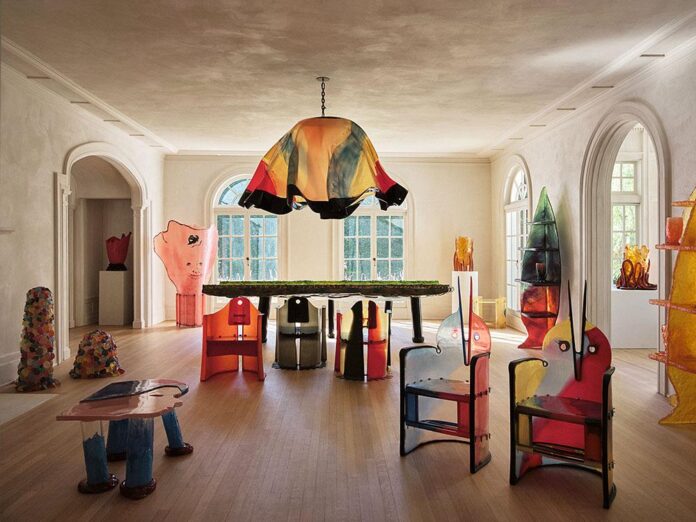Gaetano Pesce—the pioneering Italian artist, industrial designer, and architect—is the subject of the just-launched exhibition “Dear Future” (through March 31) with the Future Perfect gallery at Goldwyn House, the gallery’s new L.A. flagship (and former home of film producer and art collector Samuel Goldwyn).
Pesce certainly has a lot to tell the future, having been a leader in the design and architecture space for over five decades. So he’s sprinkled the Goldwyn House with various points he’d like to bring up with the future, objects that constitute the show. These objects include new works alongside rarely exhibited historic pieces, as well as contemporary re-editions of iconic designs.
“The future is a beautiful moment,” Pesce told Arnet News, bringing the future into the present tense. “I would like to tell the future that everything is possible, and we should give thanks for that. My work is something that people can smile about. It is a very cheerful and colorful show—and with a very positive message.”
Pesce emerged out of the Italian Radical Design movement of the 1960s. The group of designers and architects produced era-defining furnishings and products that looked to youth culture and the personality-driven ethos of the art world at the time, including Pop Art. It was a future-looking rebellion against the consumer-oriented industrial perfection of 20th-century Modernism.
As the gallery’s founder David Alhadeff said, “If Modernist architecture and design disregarded the individual and attempted to standardize the human spirit, Pesce’s life’s work has been to upend prescriptive modes of thinking—a form of counter-design that favors incoherence, unpredictability, eccentricity, and originality.”

Gaetano Pesce, . Photo: Elizabeth Carababas. Courtesy of the Future Perfect gallery.
Pesce was an eager participant in this blurring of boundaries between art, design, architecture, youth culture, and pop imagery. Uniformity became anathema to his philosophy, as seen in the imperfection of his Square Airport Lamp (1986/1994), a light sculpture consisting of a flexible rubber membrane studded with small light bulbs. Although made from a mold, no two lamps are alike, due to the imperfections that arise from the hand-mixing and pouring of colored urethane.
Early on in his career, Pesce began imbuing his work with social critique. His first and perhaps best-known furniture series, “Up,” was released in 1969 with manufacturer B&B Italia, centered around a large reclining chair dubbed La Mamma. The chair’s generously curved contours were inspired by the fertility goddess Venus of Willendorf. Yet, its attached ottoman resembling a ball and chain underscored society’s supplication to the patriarchy. This was Pesce’s comment on women’s rights at the height of second-wave feminism.

Gaetano Pesce with B&B Italia, cork. Courtesy of the Future Perfect gallery.
“The story of that chair is fantastic,” Pesce told Artnet News, “because that was a time when I was thinking that a piece of furniture can displace a political point of view. It was about the prejudice of men, the insecurity of men, the stupid ways men treat women. Not only was it a political work, it was also the beginning of design as expression, the beginning of design entering the field of art. It had become figurative.”
In “Dear Future,” Pesce included a new edition of the chair made from recycled bottle corks sourced from Italy, one of only two that have been made.
Around the new millennium, Pesce committed to creating what he called “mass-produced originals” that centered human touch. One of these is his ongoing “Nobody’s Perfect” chair series (2002/2019–present), two items of which appear in the exhibition. Cast in molds by hand, without uniform colors or dimensions, and poured freeform by the artist himself, each chair is unique.

Gaetano Pesce, chair. Photo: Elizabeth Carababas. Courtesy of the Future Perfect gallery.
“I have been saying this since I was still in school and made a manifesto about it,” Pesce said. “I think copied material is the past. We are living in a period of uniqueness that is possible because we have the technology to make all-new objects. The first company that helped me realize this was Cassina. We did a series of chairs called ‘Sit Down,’ where each piece was similar one to another but not exactly the same. This is always more and more possible, because technology is refined all the time.”
“Innovation is something that helps people to live better,” he continued, “to discover new things, to think differently from one day to the next. Innovation is not repetition.”
His insistence on originality is expressed in his 2022 series “Multicolored Lamps with Rocks,” cast in resin from stones collected by the artist himself, reminiscent of the meditative act of stacking stones into piles. Elsewhere, in Pesce’s series of pliable, gelatinous resin vases, some appear to slowly move like molten lava, while others are anthropomorphic, with tentacle-like appendages.

Installation view, River Table (2012) in foreground. Photo: Rich Stapleton. Courtesy of the Future Perfect gallery.
Another preoccupation of the artist is humankind’s relationship to nature. For “Dear Future,” Pesce included River Table (2012), a rare work from his series “Six Tables on Water,” a collection of six monumental waterscapes representing an ocean, lagoon, pond, puddle, river, and lake. With thick legs reminiscent of tree trunks, River Table’s clear surfaces evoke water’s transparency or cloudiness, with patches of darker pigment suggestive of chemical pollutants. “Water is alive, it’s a pure element; We mustn’t pollute it,” Pesce said of this piece. “Design can be a way to say, ‘be careful, we are destroying something that’s precious.”
In his theoretical letter to the future, Pesce has a special message for young people, the designers and architects of tomorrow.
“Each of us has something inside,” he said. “Young people should not look too much to magazines or follow this or that. It is important to understand what they have inside—that inside is unique. They have to express that. This is the future.”

























